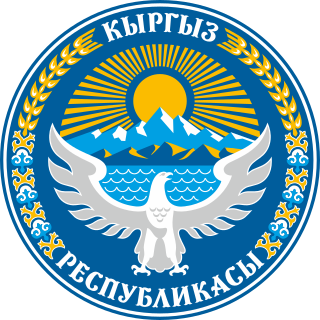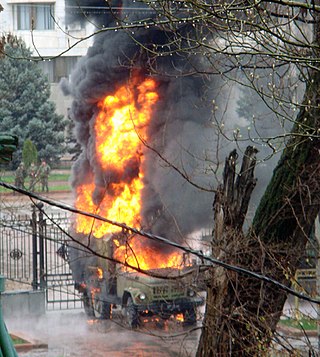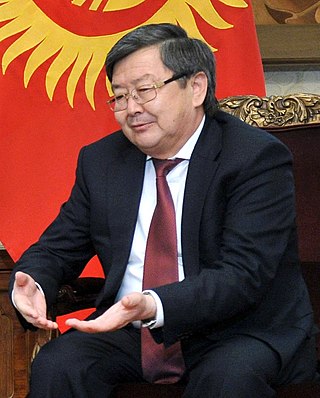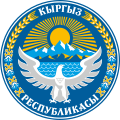Related Research Articles

The history of the Kyrgyz people and the land now called Kyrgyzstan goes back more than 3,000 years. Although geographically isolated by its mountainous location, it had an important role as part of the historical Silk Road trade route. Turkic nomads, who trace their ancestry to many Turkic states such as the First and Second Turkic Khaganates, have inhabited the country throughout its history. In the 13th century, Kyrgyzstan was conquered by the Mongols; subsequently it regained independence but was invaded by Kalmyks, Manchus, and Uzbeks. In 1876, it became part of the Russian Empire, remaining in the USSR as the Kirghiz Soviet Socialist Republic after the Russian Revolution. Following Mikhael Gorbachev's democratic reforms in the USSR, in 1990 pro-independence candidate Askar Akayev was elected president of the SSR. On 31 August 1991, Kyrgyzstan declared independence from Moscow, and a democratic government was subsequently established.

The politics of Kyrgyzstan, officially known as the Kyrgyz Republic, takes place in the framework of a presidential system representative democratic republic, whereby the President is head of state and the Chairman of the Cabinet of Ministers is head of government. Executive power is exercised by the government. Legislative power is vested in both the government and parliament. The Economist Intelligence Unit rated Kyrgyzstan an "authoritarian regime" in 2022.

Kyrgyzstan, officially the Kyrgyz Republic, is a landlocked country in Central Asia, lying in the Tian Shan and Pamir mountain ranges. Bishkek is the capital and largest city. Kyrgyzstan is bordered by Kazakhstan to the north, Uzbekistan to the west, Tajikistan to the south, and China to the east and southeast. Ethnic Kyrgyz make up the majority of the country's over 7 million people, followed by significant minorities of Uzbeks and Russians.

Askar Akayevich Akayev is a Kyrgyz former politician who served as President of Kyrgyzstan from 1990 until being overthrown in the March 2005 Tulip Revolution.
The Tulip Revolution, also known as the First Kyrgyz Revolution, led to then-President Askar Akayev's fall from power. The revolution began after parliamentary elections on 27 February and 13 March 2005. The revolutionaries alleged corruption and authoritarianism by Akayev, his family and supporters. Akayev fled to Kazakhstan and then to Russia. On 4 April 2005, at the Kyrgyz embassy in Moscow, Akayev signed his resignation statement in the presence of a Kyrgyz parliamentary delegation. The resignation was ratified by the Kyrgyz interim parliament on 11 April 2005.

Jalal-Abad is the administrative and economic centre of Jalal-Abad Region in southwestern Kyrgyzstan. Its area is 88 square kilometres (34 sq mi), and its resident population was 123,239 in 2021. It is situated at the north-eastern end of the Fergana valley along the Kögart river valley, in the foothills of the Babash Ata mountains, very close to the Uzbekistan border.

Kurmanbek Sali uulu Bakiyev is a Kyrgyz politician who served as the second president of Kyrgyzstan from 2005 until his removal from office as a result of the Kyrgyz Revolution of 2010, forcing Bakiyev to flee the country.

The Kumtor mine is one of the largest gold mines in Central Asia. The mine has been producing gold since 1997 and has produced over 13.8 million ounces of gold as of June 30, 2022. At 13,000 feet, the mine is the second-highest in the world, behind only Yanacocha in Peru.

Centerra Gold Inc. is a Canadian mining company that owns and operates the Mount Milligan copper-gold mine in British Columbia, Canada, and the Öksüt gold mine in Turkey. Through its Thompson Creek Metals subsidiary company, it also owns the Endako and Thompson Creek molybdenum mines in British Columbia and Idaho, respectively, though they have been inactive since Centerra's acquisition. The company formerly owned and operated the Kumtor Gold Mine in the Kyrgyz Republic and the Boroo Gold Mine in Mongolia. Headquartered in Toronto, Centerra Gold is a public company with shares traded on the Toronto Stock Exchange and New York Stock Exchange.

Kazarman is the village and capital of Toguz-Toro District, Jalal-Abad Region, Kyrgyzstan on the river Naryn. Its population was 11,191 in 2021.

A constitutional referendum was held in Kyrgyzstan on 27 June 2010 to reduce presidential powers and strengthen democracy in the wake of the riots earlier in the year. Parliamentary elections followed on 10 October 2010.

The 2010 Kyrgyz Revolution, also known as the Second Kyrgyz Revolution, the Melon Revolution, the April Events or officially as the People's April Revolution, began in April 2010 with the ousting of Kyrgyz president Kurmanbek Bakiyev in the capital Bishkek. It was followed by increased ethnic tension involving Kyrgyz people and Uzbeks in the south of the country, which escalated in June 2010. The violence ultimately led to the consolidation of a new parliamentary system in Kyrgyzstan.

The 2010 South Kyrgyzstan ethnic clashes were clashes between ethnic Kyrgyz and Uzbeks in southern Kyrgyzstan, primarily in the cities of Osh and Jalal-Abad, in the aftermath of the ouster of former President Kurmanbek Bakiyev on 7 April. It is part of the larger Kyrgyz Revolution of 2010. Violence that started between Kyrgyz and Uzbeks on 19 May in Jalal-Abad escalated on 10 June in Osh.

Zhantoro Zholdoshevich Satybaldiyev is a Kyrgyz politician who was Prime Minister of Kyrgyzstan from September 2012 until March 2014.

Kamchybek Kydyrshaevich Tashiev is a Kyrgyzstani politician who was head of the political party Ata-Zhurt until its merger with the Respublika party in 2014. He is currently Chairman of the State Committee for National Security.

The 2020 Kyrgyz Revolution, also known as the Third Kyrgyz Revolution, began on 5 October 2020, in response to the previous day's parliamentary election that was perceived by protestors as unfair, with allegations of electoral fraud. The results of the election were annulled on 6 October 2020. On 12 October 2020, President Jeenbekov announced a state of emergency in the capital city of Bishkek, which was approved by Parliament the following day. Jeenbekov resigned on 15 October 2020.

Sadyr Nurgojo uulu Japarov is a Kyrgyz politician who has been serving as the president of Kyrgyzstan since 28 January 2021. He previously held the post of acting prime minister of Kyrgyzstan in the 2020 interim government, following the resignation of President Sooronbay Jeenbekov. Japarov also became acting president of Kyrgyzstan after Jeenbekov's resignation, but resigned himself on 14 November 2020 to run for the 2021 presidential election, in which he was elected to succeed the acting president, Talant Mamytov.
This is a list of individuals and events related to Kyrgyzstan in 2021.
This is a list of individuals and events related to Kyrgyzstan in 2022.
References
- ↑ "Kyrgyzstan declares state of emergency".
- ↑ "Thousands Storm Canadian Mine". 31 May 2013.
- ↑ "Kumtor Mine Blockade Lifted, But Unrest Continues". Archived from the original on 2013-09-27.
- ↑ "Kyrgyzstan protesters unblock Canadian gold mine | CBC News".
- ↑ "More protests at Kyrgyz gold mine". UPI.
- ↑ "Protests at Kyrgyzstan gold mine worry family of Canadian worker | CBC News".]
